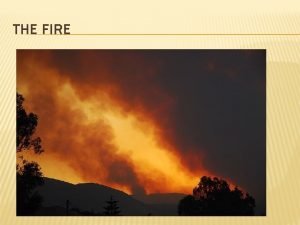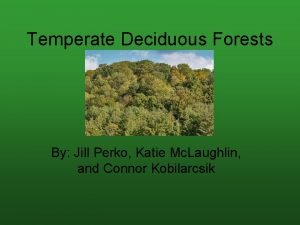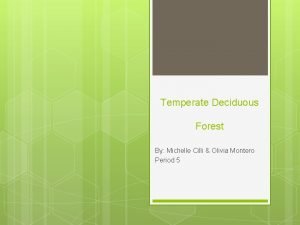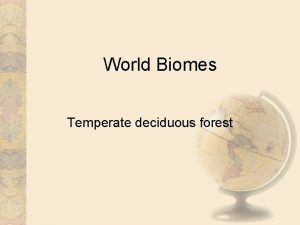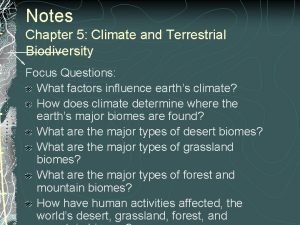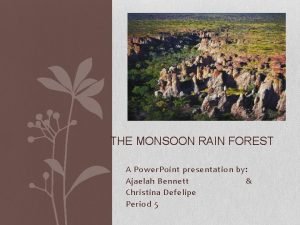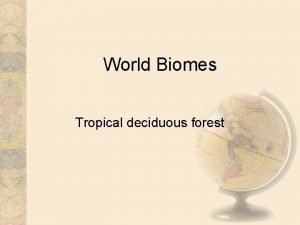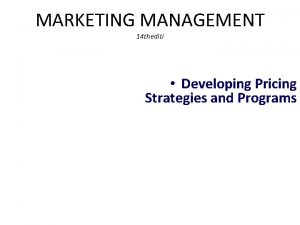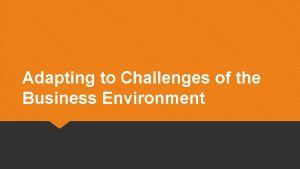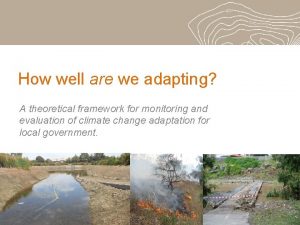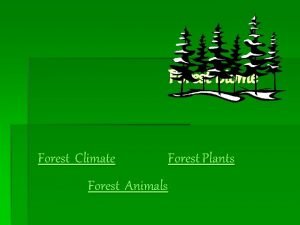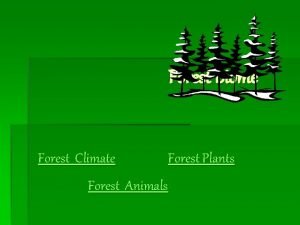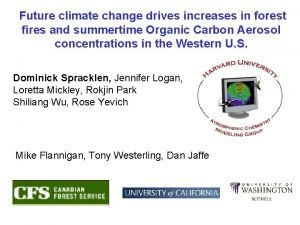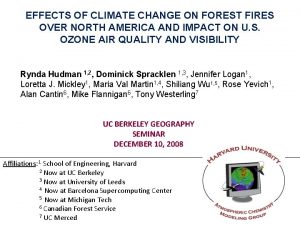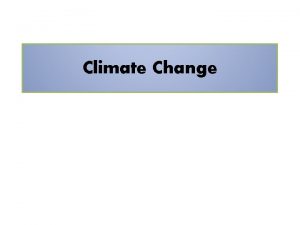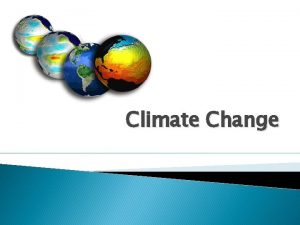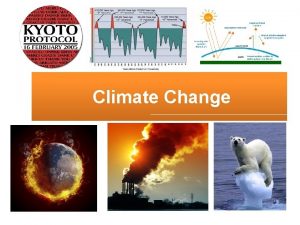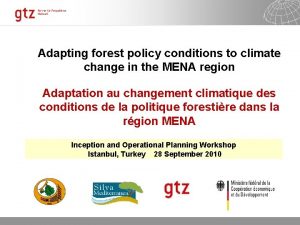Forest Fires Adapting to Climate Change in the















- Slides: 15

Forest Fires : Adapting to Climate Change in the Mediterranean Nora Berrahmouni WWF Mediterranean Programme & Pedro Regato IUCN Mediterranean Cooperation Office Special Event : Fire and Climate Change 19 th Commission of Forestry (COFO) - Rome, 16 -18 March 09

Outline 1. Introduction 2. Forest Fires in the Mediterranean 3. The Burning Combination • Climate Change impacts • Socio-economic factors 4. Adaptation Options

Introduction Results from the Conference in Athens “Adaptation to Climate Change in Mediterranean Forests conservation & Management” Organized by IUCN Mediterranean cooperation, WWF Mediterranean Programme WWF Greece 14 -16 April 08

Forest Fires in The Mediterranean FAO (2007) – fire management global assessment 2006: “ Fire is the main cause of forest destruction in the countries of the Mediterranean basin. About 50. 000 fires sweep through 700. 000 to 1 million hectares each year” Portugal, 3 August 2003 Last 10 years average: 162. 500 ha Shrubs Forest stand NASA - MODIS Rapid response system

A Burning Combination : Climate Change Generally, 2 to 6 additional weeks of fire risk Giannakopoulos et al, 2005

A Burning Combination : Climate Change Extreme weather events q Less Water availability q Frequency, magnitude and severity of extreme weather events and impacts (i. e. large-scale, uncontrolled fires) Heat waves + strong winds = Ignition risk and rapid spreading of fire Drought periods = die-back processes + dry biomass /fuel accumulation Less humidity in forest biomass Heat & Drought Temperature Water Balance Wetter et al, 2007

A Burning Combination Socio-economic factors Land use change & poor management North : Rural abandonment (dry & dense biomass) & land use changes South : over-exploitation of forest land (overgrazing, breaking branches destroying structure of forests, provoking pests, sudden death of many trees)

Adaptation Options – Fire Risk Reduction Building Fire-smart landscapes Fire management strategies & policies ü ü ü Research on forest fire (dynamics; root causes; monitoring) Risk reduction & prevention Readiness Response Recovery Collaboration between all sectors & actors (i. e. Lebanon) FAO Fire Management Voluntary Guidelines

Adaptation Options – Fire Risk Reduction Building Fire-smart landscapes Participatory planning process: The most resilient landscape pattern –distribution of land uses – against major disturbances Addressing impacts of the wider environment

Adaptation Options – Fire Risk Reduction Building Fire-smart landscapes Incentives for benefits sharing Awareness raising – living with fire Initiatives on the ground coupled with provision of a wide range of benefits for rural societies

Adaptation Options – Restoration Forest Landscape Restoration “A planned process that aims to regain ecological integrity and enhance human well-being in deforested or degraded landscapes” • Ecological integrity is “maintaining the diversity and quality of ecosystems, and enhancing their capacity to adapt to change and provide for the needs of future generations • Human well-being is “ensuring that all people have a role in shaping decisions that affect their ability to meet their needs, safeguard their livelihoods, and realize their full potential”.

Adaptation Options – Restoration Forest Landscapes Restoration Beyond trees /forest stands/ property boundaries Active engagement & negotiation The maintenance of basic ecological processes Resilient habitats/species to large scale disturbances (i. e. fire) – – Diversity of life strategies (re-sprouting; dispersal biotic vectors (fruit species); etc) Diversity of habitats (mosaic-like; riparian systems) Diversity of interventions & benefits

Adaptation Options – Human Capital Building Mediterranean Cooperation Learning Med network balancing North & South Culture of continuous training, experiences exchange Mediterranean experts body q Assessments & monitoring of changes q Measures & policies Facilitate access to knowledge for decision makers, managers, users

Adaptation Options – Profile Med Forests Increase the perception of the values of Mediterranean Forests ü Demonstrate & market the wide range of good & services : social, economic & environmental ü Engage private sector, rural development sectors ü Countries to position Forests responsible management (in and outside protected areas) as a priority at national, regional, EU.

Contacts Thank You for Your attention Contact us at Pedro. Regato@iucn. org nberrahmouni@wwfmedpo. org pieter. vanlierop@fao. org Publication can be downloaded on www. iucn. org
 Climate change 2014 mitigation of climate change
Climate change 2014 mitigation of climate change Forest fires causes and effects
Forest fires causes and effects 2007 greek forest fires
2007 greek forest fires Impact of climate change on forest ppt
Impact of climate change on forest ppt Connor perko
Connor perko Energy pyramid for temperate deciduous forest
Energy pyramid for temperate deciduous forest Deciduous forest rainfall
Deciduous forest rainfall Amazon rainforest temperature graph
Amazon rainforest temperature graph Monsoon forest climate
Monsoon forest climate Tropical deciduous forest location
Tropical deciduous forest location Paiboc model
Paiboc model Audience analysis example
Audience analysis example How well are we adapting
How well are we adapting Adapting the price
Adapting the price Adapting to challenges of the micro environment
Adapting to challenges of the micro environment How well are we adapting
How well are we adapting


